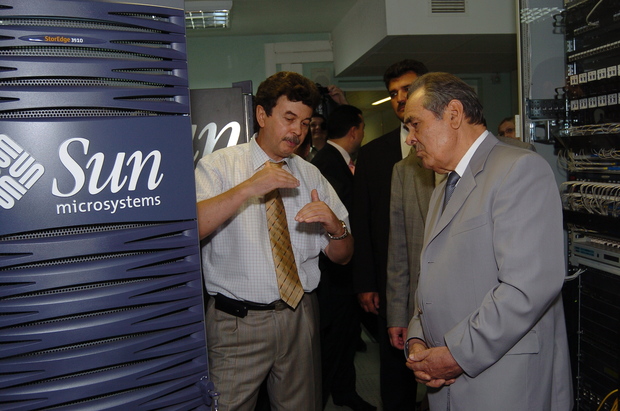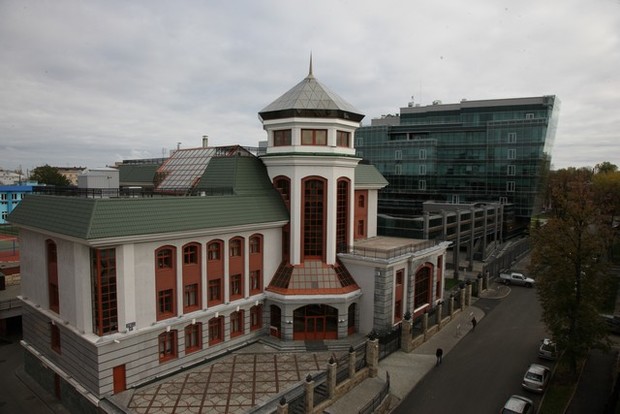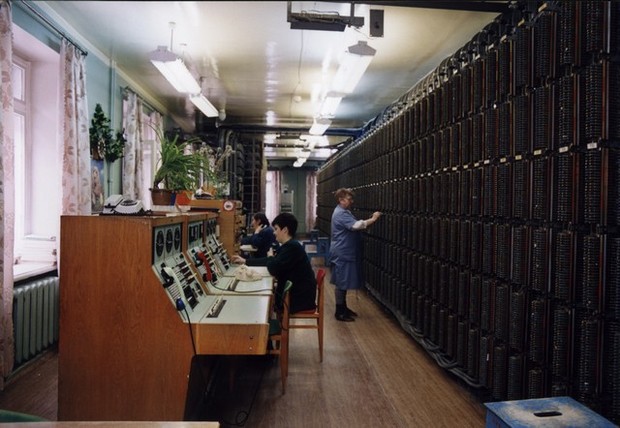Shaimiev’s first mobile call or how Santel gathered 300,000 users within two years
History of a regional operator invested in the creation of the first mobile network of world level in the republic
Today's smartphones, which are not just simple means of communication, don't substitute fully-fledged computers in terms of serious work but allow to create simple documents from scratch and immediately place them in the cloud or send via e-mail. In these conditions, one could not imagine that a wireless call was a sheer miracle. It was a miracle just 17 years ago, that is to say, in 1999, when the first phone call of Santel GSM operator of TAIF-Telcom was made in Tatarstan. The next material of TAIF-25 special project tells about what kind of connection preceded GSM standard, how to accelerate the growth of the number of users, and what difficulties were on the way in the implementation of mobile communication.
$2,500 for a phone
Today every house and every device has a possibility to use 4G and work, study or entertain in the most different multimedia formats using a heavy content. And we don't imagine even a day without our phones. But mobile phones and the Internet were unavailable not only for ordinary people but also the elites only 20 years ago. To have an access to the Internet or make a mobile call were like going into space – expensive, not available for everybody and a mind-boggling thing for the majority.
'At that moment it was inapproachable,' the Minister of Health of Tatarstan Adel Vafin remembers in one of his interviews. 'I remember a phone cost $2,500, firstly. Secondly, in 2000, I still had a pager but I was an owner of the first mobile phone in my life. Santel was the operator. Undoubtedly all urgent problems were solved faster, especially when we speak about consultations in clinics, it all became more available.'
At the beginning of the noughties, Santel truly was a certain business card of Tatarstan. It is the first, the main mobile GSM operator, and the largest local company with 334,000 connected users and 221 base stations. Services of the mobile network of TAIF-Telecom covered over 98% of the territory of Tatarstan. Moreover, the baby of TAIF made good money. In 2002. Net profit made up $15m within a year, its revenue was $46m. These figures were big for that time. But the history of creation of the cellular network did not start with Santel.

Hundreds of thousands of dollars went out of the window because of the absence of сommunication
Today few people know that before the creation of Santel, TAIF elaborated several systems of networks – each time investing in elaborations and infrastructure and making better technologies and quality of services.
In 1993, a subsidiary of TAIF – Radiophone Technologies and RTT – appeared in Tatarstan first. Its appearance was conditioned by operational needs. The administration of industrial enterprises understood that the business lost hundreds of thousands of dollars monthly just because the enterprises could not be in touch in time with their partners, state services or, let's say, captains of tankers transporting the petroleum of Tatarstan. The problem generated an innovative idea – it was decided to create their own mobile network and develop the telecommunication of Tatarstan to the level of the developed countries of the world.
So, TAIF rolled out a system of quite an acceptable at that time trunk radiotelephone communication. The new service, as it was expected, was popular among the first clients – producers. The collective of RTT was small at the beginning, but its workers studied in Finland, obtained a European certificate that permitted them to work with the equipment that Finnish Nokia delivered to RTT. The specialists were responsible for installation and use of the equipment that provided trunk radiotelephone communication. In fact, huge receivers with big, heavy and quite expensive cases were that equipment.
In 1994, RTT already started to use the equipment covering a distance from Zelenodolsk to Naberezhnye Chelny. 'Everything was done in a hurry,' Valery Trofimov, the head of technical department of RTT at that moment and the first deputy director general of TVT PJSC later, remembered. 'We used high-rises and built a 50-metre tower on Kazan-Chelny highway to install antennas and place the equipment. Three base stations were in Kazan – a high-rise of Kazan State University, the TV tower and in Gorki micro district. The commutator was on Butlerova Street.'

They started to connect the users after the ceremonious opening. The number of people who wished to use the radiotelephone system exceeded 6,000. Neither its price at almost $3,000 nor tariffs ($5 for a minute) scared the users.
Communication via phones, which weighed 0,5 kilo, was popular among industrialists and oil workers. Tatneft used its network called Altay, which was created at the end of the 60s. Antenna system worked according to the principle of mobile network – with one or several base stations. A restricted quantity of users was the main disadvantage of Altay. The implementation of trunk mobile communication allowed the oil workers to improve a quick information gathering from their wells extracting administration and oil package units. And they willingly signed an agreement on cooperation with RTT, and phone users of TAIF could use their radiotelephone in Zakamye (beyond the Kama River), and users-oil workers could use their devices in Kazan. All people had a united local number. Later RTT signed an agreement with a firm from Moscow that used the same network in Moscow and Moscow Oblast. So, the users of RTT had a possibility to use the network also in Moscow.
'At that time, operators of wired communication we paid for entering their network to did not think we could compete – the number of our users was not comparable with their army of users,' Valery Trofimov remembers in one of his interviews. 'The administration of the republic and the Ministry of Communications was very interested in the possibility to have a connection not only in Kazan. They started to use our services soon.'
Later in 2000, TAIF sold RTT to Tatneft that wanted to buy it in order to substitute the vestige of the Soviet era – Altay.
But it is necessary to note that RTT, which is almost forgotten, played a major role in the development of the republic. It was a pilot that was not only a launch pad for the future large-scale telecommunication project of the company but also defined the circle of potential consumers of the services of the mobile connection of the republic at that moment. This experience allowed TAIF to feel the potential of a new forming mobile market, to look ahead and create a more ambitious project Santel.
$70m to the Swedish for science
An analytical group was created in TAIF for this intentions. The group studied the possibilities and prospects of the telecommunication market in Russia and worldwide. The administration of TAIF decided to stake on the prospective but absolutely new GSM standard though experts offered to continue to develop trunk communication network. A rapid development of GSM mobile network in Europe and Russia started in 1997, and TAIF thought about the creation of this network in Tatarstan. The company started the construction of the regional network called Santel. In Tatar, san means number, tel – language, that is to say, a language of numbers, a digital communication.
The creation of Santel in the end of the 90s was ahead of the time in many aspects. As an innovative thing, on the one hand, it was given a considerable handicap and a possibility of rapid development, and on the other hand, it had to develop when there was no organized market. No one believed in the popularization of mobile communication. A permission for use of frequency bandwidth was quickly given by the State Commission on Radio Frequencies in Moscow with the agreement of special services as well as the licence of the Ministry of Communications of Russia that allowed TAIF PJSC to start the realization of the project on implementation of the system of GSM-900 mobile network in Tatarstan. 'Because no one believed that it was possible to make money on communication and that it would be widely used,' Albert Shigabutdinov remembers.

This step proved its values as time went by though it was risky: the 'raw' standard took the leading position in the world some years later. In November 1998, TAIF-Telcom was the first in the region and one of the first among the regions of Russia owner of the licence to offer its services of GSM-900 mobile network. Only Kuban-telecom, which covered all population of Krasnodar, was ahead of Santel.
Plans of Santel were ambitious – to have 100,000 numbers by 2003. It was decided to cover the route from Zelenodolsk till Almetyevsk and all passing villages and cities. They needed to build 52 base stations. The specialists of TAIF talked to western companies, studied their experience and started to negotiate.
A $20m contract was signed first after a thorough elaboration of the project, and then a $50m agreement on delivery of equipment was signed with Swedish Ericsson. The equipment presupposed an implementation of the most ultimate mobile technologies, including high-speed Internet access, for the first time in Russia. So, TAIF-Telcom planned a modernization of the existing commutator by means of the implementation of a new software of Ericsson and equipment of additional base station that included a new product of Ericsson – MAXITE-900.
The equipment was delivered on 29 December 1997, just before New Year. A New-Year 'present' from Sweden consisted of three big lorries: a commutator, antennas, wires, base stations and a part of receivers. A contractor from Moscow, which was hired by Ericsson, installed the first 14 stations in Kazan, so, the 51st station was launched by autumn.
Thanks to TAIF even the users of Santel in the most remote districts of Tatarstan, where there was not any fixed access to the means of communication, had a possibility to use the Internet connecting their computer to the mobile phone. Data transmission speed using the technology of Ericsson HSCSD reached 38,8 Kbps. At that moment, it was the highest indicator for mobile networks in Russia.

'We don't have money. Do yourself if you want'
TAIF-Telcom faced one problem more – the impossibility of connection of mobile network to public switched telephone networks. It turned out that 95% of the stations of fixed communications in Tatarstan were based on Strowger switches created 50-60 years ago. The old equipment made the possibility of the interface of the modern digital system of mobile networks with stationary analogous networks problematic.
It turned out that TAIF managed to create a mobile network that allowed mobile phone ownersto be in touch, but it was very expensive and difficult to call from a mobile to a stationary phone. It caused a discomfort. Morally old analogous equipment of Automatic Telephone Station needed to be substituted for electronic digital commutators. The administration of TAIF offered the Ministry of Communications of Tatarstan to break the deadlock together.
'We don't have money. Do yourself if you want. We will give three-four stations, you will modernize them gratis,' they were told in the Ministry. TAIF offered its variant: to buy two stations, pay off and carry out a complete modernization of two old stations in Gorki and Sotsgorod micro districts on its own. These two stations belonged to the Ministry of Communications. So, TAIF participated in the creation of one business more.
IntelSet was created in 2000. Its collective started to equip the nets with the most up-to-date digital equipment using a platform of computer telephony. All in all there was a double win: modern digital Automatic Telephone Station was introduced instead of the old telephone stations. Having connected the mobile connection to the networks of public use, TAIF could get rid of its financial load. Apart from a manyfold reduction of the costs of calls from a mobile to a stationary phone, the cost of inter-urban and international conversations decreased.
As the time demonstrated, the history of the creation of the first mobile operator of the republic did not end. SanTel had one modernization more, which was also caused by an explosive rush of users, TAIF-Telcom had a severe war with federal operators for Tatarstan towers, and TAIF had an incredible offer to build regional communication networks. These historical moments like the formation of the mobile market of the republic will be published further on.
Photo: press centre of TAIF PJSC